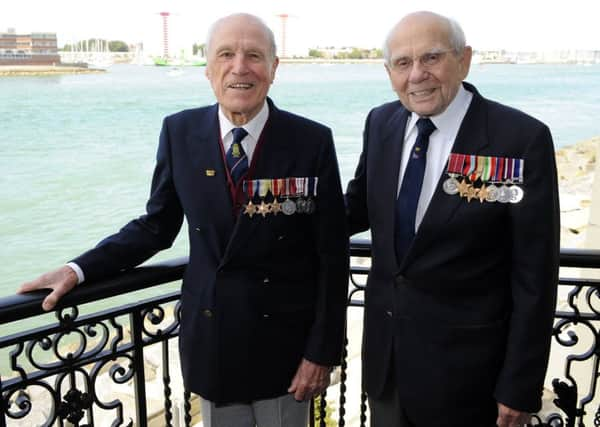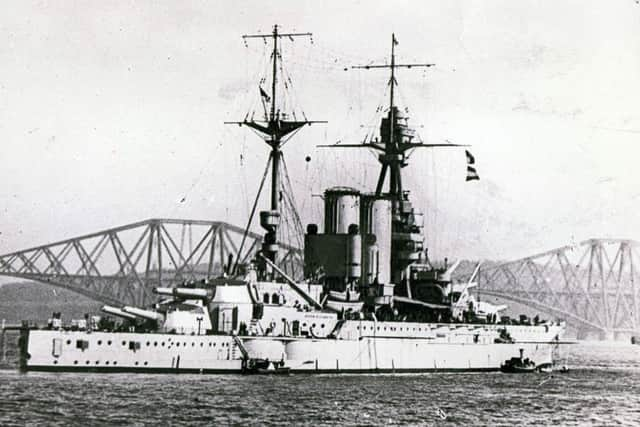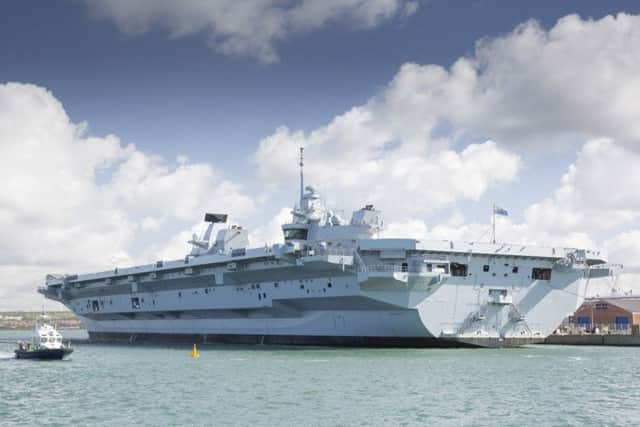'˜Our time on her was truly unforgettable' - veterans of Second World War battleship HMS Queen Elizabeth reminisce as new carrier brings name back to navy


The pair of naval veterans have been friends for almost 80 years since they joined the battleship HMS Queen Elizabeth in 1941 as teenage boy sailors.
Stepping into a brightly lit communal room of Cornwell Court, where Vic lives, the pair pause their chat to welcome me.
Advertisement
Hide AdAdvertisement
Hide AdDespite my protestations, the proud duo rise to their feet sheepishly to shake my hand. Beaming with smiles from ear to ear, the veterans both shake my hand with a grip that belies their age.


They each ooze the confidence of men who have proudly served their country.
‘So what would you like to know then, lad?’ Len chuckles as he gently lowers himself back into his chair and bites into a biscuit.
That was a good question. It was difficult to know where to start. The duo’s history is packed full of action, from numerous battles in the Second World War and nail-biting tales of dodging Nazi bombs, to overcoming horrific wounds and continuing to serve in the Royal Navy.
Advertisement
Hide AdAdvertisement
Hide AdBut to begin with I opt to find out their thoughts on the Senior Service’s newest warship, HMS Queen Elizabeth – the first warship to hold the name since Len and Vic’s time.


‘She is really awesome,’ says 93-year-old Len.
Vic, also 93, adds: ‘It’s a feeling of pride seeing her. It takes me back to my time at sea.’
The pair were next to each other to watch the 65,000-tonne ship’s Portsmouth homecoming last month.
They began their training in 1941 on the Isle of Man before coming to Portsmouth to join Queen Elizabeth on their first draft.


Advertisement
Hide AdAdvertisement
Hide AdBut with the Luftwaffe already battering the south coast and their sights firmly fixed on hammering Portsmouth, the ship had been moved north to Rosyth.
It was during the long train journey across the country and up to Scotland that Len and Vic first met as 16-year-old boy sailors.
Living on ship for the young lads – who had barely finished school – was a new experience.
Queen Elizabeth was a battleship bristling with four twin 15-inch guns, 16 six-inch guns and two single three-inch guns as well as a crew of more than 1,200.


Advertisement
Hide AdAdvertisement
Hide AdShe already had plenty of history under her belt having fought in the First World War.
‘The ship was full of characters,’ says Len. ‘We had a very high proportion of naval ‘pensioners’ recalled during the war and 100 boy sailors.
‘It was a remarkable experience to be on a ship like HMS Queen Elizabeth.’
It wasn’t long before the ship was in action. First deployed to the South Atlantic the vessel was then tasked with joining the fleet in the Mediterranean.
Advertisement
Hide AdAdvertisement
Hide AdThe warm waters of the Med were anything but welcoming as Queen Elizabeth faced regular attacks by Italian and German planes.
One of their first wartime operations saw Len and Vic joining Operation Tiger.
The mission was to escort five transport vessels laden with hundreds of tanks and 43 Hurricane fighter planes from Gibraltar to Egypt to reinforce British forces in North Africa.
Queen Elizabeth and her fellow escort ships were constantly harassed by torpedo bombers.
Advertisement
Hide AdAdvertisement
Hide Ad‘Flying blind at night was frightening,’ says Vic. ‘The chaplains used to comfort us at night.’
The ship managed to escape unscathed, delivering much of the supplies.
But she wasn’t so lucky while in the harbour at Alexandria later that year.
She was mined and sunk by an Italian human torpedo attack on December 18.
Advertisement
Hide AdAdvertisement
Hide Ad‘We had a pipe (call) at 3am warning us that underwater swimmers were in the harbour,’ says Len. ‘I was in my hammock off watch but I didn’t sleep. There were depth charges being dropped to get the Italians. It was so loud.’
The charges were unsuccessful and the mine attached to Queen Elizabeth blew up.
Remarkably, although low in the water, the ship’s crew were able to maintain the illusion of full operational status, concealing the damage.
After this the pair left the ship and went to different vessels. However, their paths would cross once again while the ship Len was on, HMS Kipling, was sunk.
Advertisement
Hide AdAdvertisement
Hide AdVic was part of the team to rescue his injured comrade and hundreds of other sailors.
Len’s ship had just rescued the men of HMS Lively following a bomber attack when his ship was hit.
‘I was knocked completely unconscious,’ says Len. ‘I had multiple burns and a fractured spine. I regained consciousness on a Carley float just before the ship sank.’
Vic saw his wounded pal, who was transported to HMS Jarvis. ‘He was covered in oil and bleeding from his head.’
Advertisement
Hide AdAdvertisement
Hide AdAfter recovering, Len remained in the navy for 35 years, retiring as a Lieutenant. Victor left as a Chief Petty Officer.
The pair both live in Portsmouth and remain good friends.
A TALE OF TWO QUEENS
THE first Queen Elizabeth was built in Portsmouth and launched in October 1913, entering into service in 1915.
During the First World War she took part in the Dardanelles campaign attempt to knock the Ottoman Empire out of the war.
Later, in 1918, she took part in the surrender of the German High Seas Fleet.
Advertisement
Hide AdAdvertisement
Hide AdBetween the wars she acted as the flagship of the Atlantic fleet and was rebuilt during 1926 and 1927, having new weapons fitted.
When the Second World War broke out, Queen Elizabeth joined the Mediterranean fleet and was seriously damaged by Italian divers in Alexandria in December 1941.
After being repaired in America, Queen Elizabeth saw action in the Far East before eventually being sold for demolition in 1948.
Efforts to build the new Queen Elizabeth began in earnest in 2009 with steel being cut.
Advertisement
Hide AdAdvertisement
Hide AdShe was completed this year, with her ship’s company moving on board in June. Her sea trials took place later that month in the North Sea.
The aircraft carrier made her debut in Portsmouth on August 17.
The 280m vessel is the biggest ever built for the navy. She is expected to leave the city next month to continue her sea trials.